Review by Dan, Photos by Robban, Neehar, Blade-of-the-Moon, and Jeremy K.
Sideshow offered a first glimpse of the Apatosaurus maquette in September 2010. No fewer than eleven months later, it has finally been released. It is the second, and final Dinosauria statue to be offered in 2011. Once churning out new models on a quarterly basis, it seems Sideshow is attempting to take things a little slower with the Dinosauria line.
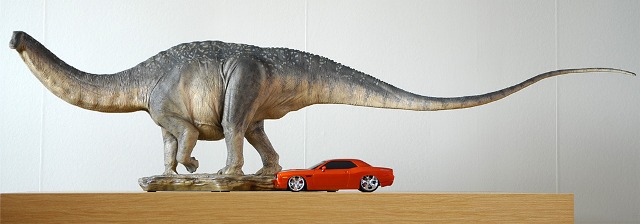
The Apatosaurus is the longest of the bunch so far, at a whopping 43″ and weighing in at about 10 pounds. Since most of the extra length comes from the tail, it is perhaps understandable that it’s selling for about the same price as the Spinosaurus. With many high-end models, the long and delicate tail becomes a point of concern during shipping. However, careful use of foam padding by the manufacturer appears to have curtailed most tail-related injuries to the model. This signature feature of the Apatosaurus is presented with surprisingly minimal flourish, just a gentle undulation implying graceful movement. It does comprise about half the statue’s total length, so care should be taken when displaying this model in high-traffic areas.
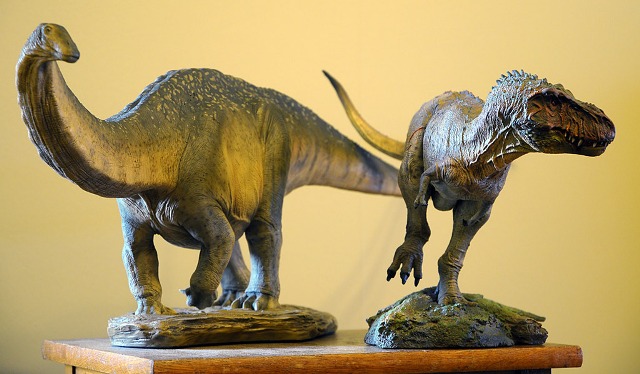
According to the artist, this reconstruction is based on the species type A. louisae. The stock photos of the original prototype sculpture suggest a lustrous, golden coloration, not unlike the Carnotaurus. Much like her fleet-footed predecessor, however, the final product differs substantially in paint application. The base tone seems more grey than gold, while the darkened paint patterns are charcoal instead of brown. Popular opinion dictates that a neutral color scheme is appropriate for a large animal like this – despite there being no animal quite like this today – and it will likely cause no major fuss.
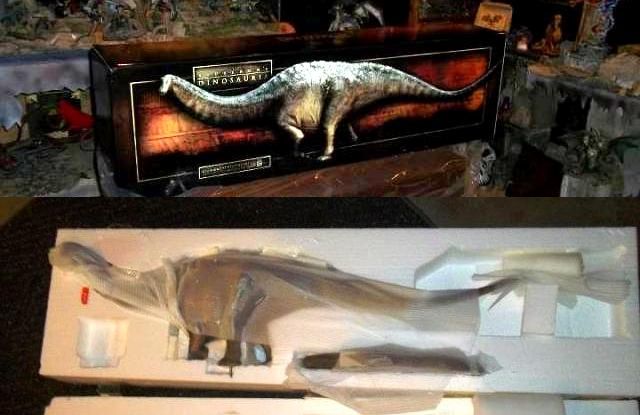
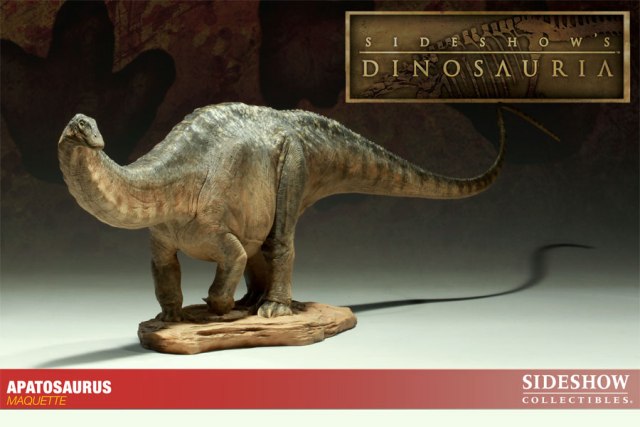
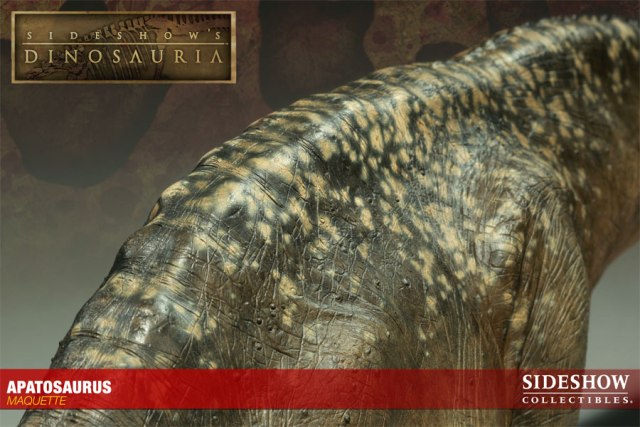

Some may find the technique of application itself to be more noticeable. In the stock images, the Apatosaurus has a dappled pattern running along its backside – a striking effect that has been lovingly described as “sunlight filtering through the treetops.” This effect has lost some of its intricacy under the yoke of mass production. The dorsal side appears to have been dabbed repeatedly, adding (or possibly removing) paint to produce a sporadic arrangement of spots. This is only noticeable when inspecting the statue at close range, however. The brown eyes with black pupils are also a bit rough looking, but again, it’s not very distracting at normal viewing distance. A solid glossy black may have provided better realism, as some figure companies have done. In fact, they are recessed deeply enough that they already seem like a very lifelike solid black.


Another feature that keeps the animal from looking too bland can be seen in the rows of stripes lining the body. On both the tail and neck, they taper downward in somewhat triangular shapes, spotty but soft in their application. There also appears to be some subtle dry-brushing along the paler underside, highlighting the magnificent textures built into the massive physique. Sharp-eyed observers may notice attachment seams where the feet are connected to the legs, but with so many wrinkles across the body, this is very well concealed. The feet appear to be properly formed, with a single claw on each forelimb and three on the hindlimbs. The smaller front feet have the “horseshoe” shape, made evident by the animal lifting one of its legs as it ambles along. It would have been nice if the feet were more dark and sullied, but looking at the environment of the base, the ground color does appear to be close to her natural color.

The base for this model contains the usual footprints for guiding the character into position, and a single hole for inserting a peg that protrudes from one of the feet. Since this peg no doubt runs deeply into the model, customization should be done with great caution. Although the character may stand fairly well on its own three feet, stability is really best when using the peg insertion, so even a custom-crafted base should take advantage of this feature. In addition to the guide-prints, there are a few other trackways visible on the base. One can find the freshly pressed prints of our star sauropod, as well as the prints of at least one other, smaller member of the herd. Along her right side, a three-toed trackways is also visible, presumably from a recently lingering Allosaur. Next to her own prints, they seem tiny and birdlike, considerably less menacing than they were in a certain violent encounter.

This giant is densely decorated with rich surface detail. This is an area where mass production often falters, or at least yields inconsistent results. Luckily, the replication of these details has been very well done for Apatosaurus. No matter how one feels about the paint application, the sculptural detail is actually so impressive, it overwhelms any minor flaws in the paint. If you spend considerable time admiring the details in a sculpture like this, prepare to reschedule your day, as Jorge has packed plenty of texture work into this colossal canvas. Unlike Jorge’s Stegosaurus or Protoceratops, the Apatosaurus bears little in the way of scales and scutes. Instead, the animal struts proudly in a wrinkled, elephantine skin that bags and sags, bunches and folds in all places demanded by the laws of physics. Granted, scales wouldn’t necessarily be visible in a scaled down sauropod – hard as it may be to remind ourselves this is a scaled down model – and the effect recalls the timeless grace of a sauropod from the Invicta line.

“When the Sideshow team commissioned me to build up an Apatosaurus sculpture for its Dinosauria line, I couldn’t be happier, as this one of my favorite dinosaurs since childhood. So I made some sketch designs where I put everything I knew from sauropod anatomy. The books by experts as recognized as Gregory Paul, Tracy L. Ford, and especially my mentor, Jose Bonaparte were of great help. With all that in mind I faced the task of creating my own version of such a beautiful dino.
“As an artist there are choices to be taken in order to express a vision at once personal and so anatomically accurate as possible. In this case I decided to represent a healthy, young individual. May be in the mating season. I put an extra special care when happen to represent the back muscles, the neck, tail and legs. These are quite different from the theropods since they posses a distinctive locomotive way. The tail should be long and narrow, but a little stiff. Not so flexible and mobile like a whip. Due to the fact that this was a massive animal that walked a lot, the shoulder blades had only the necessary mobility and are not so exposed like in the case of a mammal, which needs to be agile, for instance a contemporary big cat.
“I indulge myself with the comparison between some actual animal’s anatomies in order to give my work a touch of aliveness (even though there are no animals nowadays that can compare with a sauropod). The general idea was to try to recreate the appearance of a living creature, something that you can recognize like a possible organism. Something with a real weight and movements, likeable to see. Maybe, and this is strictly an analogy, an animal which makes a contemporary beholder think of an elephant, only as an example of a majestic animal, massive and bold and elegant at the same time. There is also a little touch of reptilian attitude and behavior. “ – Jorge Blanco
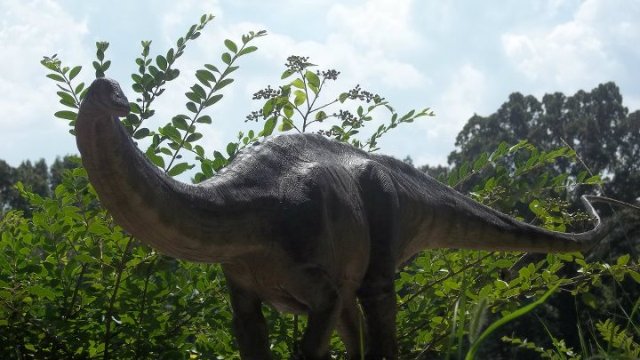
Many will recall the Diplodocus shown in Walking With Dinosaurs, with its rows of neural spines and goofy exposed teeth. For mainstream audiences, this is probably the most recently prevailing mental image of a diplodocoid. And while plenty could be said of the accuracy of WwD at the time it was produced, it interesting to see just how much our knowledge of these animals has changed just in the past few years. In this reconstruction, the spines are mostly concealed along the back; only a series of short ridges are exposed, beginning at the pelvis and reducing toward the posterior. The spatulate teeth are politely hidden behind lips, which are once again widely seen in contemporary sauropod reconstructions. Among other diplodocoids, the Apatosaurus is known for being quite robust. This is not particularly new knowledge, but it provides a nice point of distinction for Apatosaurus all the same. Very often, skeletal reconstructions form the basis of fully-fleshed models, while providing little in the way of actual flesh. The resulting models end up looking emaciated, a walking undead dinosaur comprised of tightly bound skin and bone. This is clearly not the case with Jorge’s sculpture.
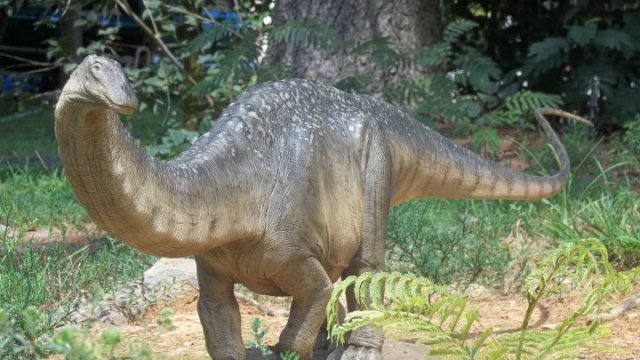
Thick muscles line the columnar legs, while carefully crafted bulges reveal the barest hint of the massive bone beneath. The ribs and chest are enormous, with an appropriately huge gut that would have housed an immense community of bacteria for fermenting plant material. The neck is quite possibly the thickest I have seen in any recent reconstruction of the species. The bifurcation at the neck results in an interesting channel, rather like the Krentz version. According to paleontologist Mike Taylor – who may yet be lured back with this review – the channel might have been filled through with air sacs in life, and therefore less concave. Apparently, Jorge saw this Apatosaurus as a younger creature than the Dinosauria backstory would have us believe, which describes an aged matriarch. This discrepancy isn’t really a problem though, since the Dinosauria line does not follow a strict scale.
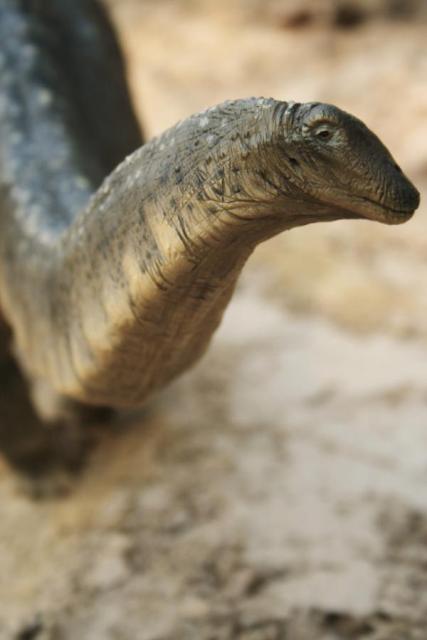
The artist also flexes his intellectual muscles by presenting Apatosaurus in a way that emphasizes its majesty, without sacrificing scientific credibility. This is sometimes a fine line to walk, even among the Sideshow Dinosauria statues, where the dramatic flair sometimes stretches the limits of the animal’s anatomy (Some may recall the sharply curled tail of the Parasaurolophus, for example). However, Jorge’s design is pretty conservative. The posture isn’t rearing, the tail curling is minimal, and the head cranes at about an eighty degree angle from the body. It’s a seemingly small touch to add interest to the piece, yet it provides such a lifelike quality by showing an animal that is actively observing its environment.
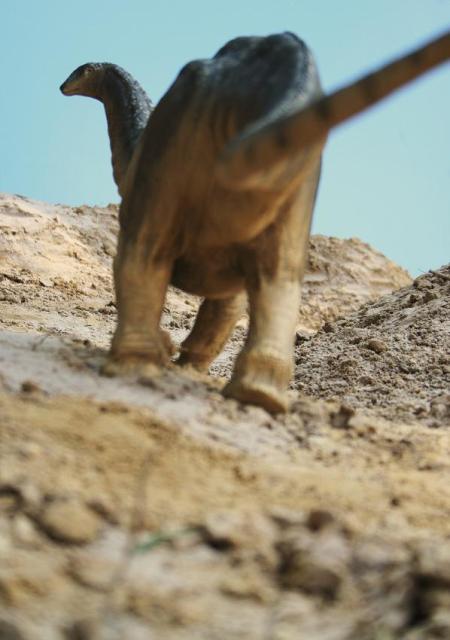
Does the Sideshow Apatosaurus deliver exactly what was promised in the stock photos? Not exactly. Is is still worth owning? If you can afford it, I would say it is absolutely worthwhile. Even ignoring the long-term value of the piece – which is typically great for any Dinosauria statue – this is an exceptional work of art that only a limited number of people will have the chance to own. It is one of the finest statues in the Dinosauria line, its presence in a room is undeniable, and it is just awesome to look at. The Sideshow Apatosaurus does not rely on high-octane action, graphic violence, or intricate colors to draw the eye. It is big and beautiful, and it’s the ultimate representation of a dinosaur.
Available here.
Disclaimer: links to Ebay and Amazon on the DinoToyBlog are affiliate links, so we make a small commission if you use them. Thanks for supporting us!




Love this dinosaur so much and I couldn’t find one online anymore. Is there by any chance you are willing to sell yours:)
I have an original issue Apatosaurus if you’re interested.
I’m interested if you still have it. By original, did you mean this model you just reviewed?
[…] level of scientific accuracy, Jorge Blanco is known for reconstructing these giants with a primal robustness. This is a considerable contrast to the leaner, more “shrink wrapped” reconstructions […]
[…] more opinions? There is a thoughtful review of this maquette at the Dinosaur Toy Blog, with a comment from Mike that was probably the genesis of this whole […]
Well, you guessed right, here I am 🙂
I was going to comment before you namechecked me, just to say what a sensational piece of work this is. It’s astounding how far sauropod models have come in the last ten years. In particular, it does my heart good to see the super-thick, near-triangular-in-cross-section neck, something that Apatosaurus sculptors have almost universally got wrong in the past.
Regarding the trough along the top of the neck: it’s not completely clear in the photos here, but it looks like it’s very subtle. I wouldn’t rule it out.
Great review~!
I really can’t wait to receive mine! (Unfortunately which would take at least a couple of months to arrive from now)